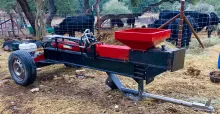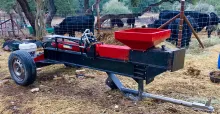The machine, dubbed the "Biomass Beast" by Rose, was built for $2,375 and Rose demonstrated production of briquettes at a rate of 90 dry pounds per hour for 3 cents per dry pound. The briquettes were found to have 6,481 BTU/lb (at 10.5% moisture content) which compared favorably to dry cord wood (e.g. 5,649 BTU/lb for sugar maple at 10% moisture). They burned easily and well. All in all, the cost of production and the heating value suggests that these briquettes deliver energy at a cost of about $4.4 per million BTU (roughly the equivalent of $105 per cord of firewood or $0.60 per gallon of fuel oil).
Background
Rose Marie Belforti was interested in finding ways to manage excess livestock manure on her small farm. She learned that manure fuel briquettes have been used on small farms by many cultures around the world for centuries, but typically they have been made by hand and do not have the BTU’s acceptable to meet modern heating needs. Biomass fuel briquette machines currently on the market in the U.S. are designed for large production and are not practical for small farm use. Therefore, Belforti sought to design and test a prototype of an affordable hydraulic press scaled for small farm use that would sufficiently compress a raw manure/bedding mixture into brick form to be used as a heating fuel.
The Project
She was able to test the idea out with the support of a Farmer Grant project funded by the Northeast Sustainable Agriculture Research and Education Program (SARE). Belforti received a SARE Farmer Grant (FNE17-862) last year to design and construct a hydraulic press to form fuel briquettes from livestock manure and to test them.
Belforti worked closely with a local welder, Steve Lonsky, and also with technical advisor Chris Callahan, at UVM Extension to develop the press prototype that cost less than $2,400. She then tested different ratios of fresh manure, bedding (straw and wood shavings), and water to come up with a recipe that would press and dry efficiently and have reasonable density. Briquettes were analyzed for quality and heat value. Compared to cordwood, livestock manure pressed briquettes rated well for BTUs per pound; however, ash content was higher than cord wood or wood pellets.
Results
The press cost $2,103 in material to construct which included all new materials except for tires. The cost could be considerably less if on farm equipment already in hand would have been used. One could also, with welding skills, modify a wood splitter to have a dual purpose machine. A typical briquette size is: 7” high x 9” wide x 9” long. The dry weight is approximately 3 lbs for a briquette that size. Belforti was able to produce 90 lbs of dry briquettes per hour. Drying is done in ambient conditions, protected from rain, using the heat of the sun (e.g. in a greenhouse). The cost of fuel to run the machine is about 3 cents per pound of dry briquette.
The fuel testing demonstrated “dry” moisture content of about 10.5% using simple, passive techniques with some ventilating air flow but and no supplemental heating. The briquette fuel was tested for heating value and was found to have 7,673 BTU/lb (moisture free). This equates to 6,841 BTU/lb (at 10.5% moisture). Ash content was relatively high at 18%.
Combining the cost of production and the heating value suggests that these briquettes deliver energy at a cost of about $4.4 per million BTU (roughly the equivalent of $105 per cord of firewood or $0.60 per gallon of fuel oil). The amortized cost of the machine and labor is not included in these early cost estimates.
Based on results of the project, Belforti concluded that livestock manure briquettes can be a feasible fuel source for the small farm, particularly those with surplus livestock manure. Photos of the press and construction information as well as fuel analyses are available on Farm Hack and are included in the final project report, available on the SARE website.
Material List:
- Honda OHV engine 270cc GX series 8.5 hp was recommended for enough power to compress the blocks. $557.98 There are certainly many other choices.
- Hydraulic cylinder – 3000 PSI 2” bore, 10” stroke to open the door to let the brick out of the press: $97.99
- Hydraulic cylinder – 3000 PSI 5” bore, 24” strike to press the bricks: $309.99
- Hydraulic pump: $189.99
- Spool lever operated valve to move the cylinder: $204.21
- Hoses and parts: $67:18
- Steel parts and Spindle: $477.66
- Bolts, nuts, washers, coupling spider, couplings: $67.87
- Ball hitch: $17.98
- Cans of black paint: $6.42
- Steel for fabrication: $120.00
- Hoses and parts: $67.18
- Oil filter and misc. parts: $27.59
- Pipe and fender washers: $12.62
- Clamps etc. $41.07
- Stainless steel for hydraulic fluid tank: $60.00
- parts for hydraulic set up: $42.53
- Notebook for manual: $6.37
- Total Materials: $2,103.24
- Fabricator labor for 146.5 hours for making and assembling parts: $3,662.50
- Total Cost $5,765.74
Contact: Rose Marie Belforti, himmelhaus92@gmail.com
In general, we are trying to make the best fuel brick for the purpose of burning in a wood stove or fire place for heat or for cooking, documenting all work and publishing the results so that other interested farmers and homeowners with a beautiful abundance of livestock manure can make their own press.
We began with several trial runs. Mixtures of different amounts of dry manure with bedding, fresh manure and water to make the manure briquette. The measure of excellence is that the briquette must hold together so that it can be handled and set to dry. If too moist they will not survive the pressing, if too dry, or not well mixed, containing pockets of dry and wet, they will crumble during handling as they exit the press.
Trial runs and results (note that measurements were not exact or perfect, but approximate.)
Test #1
6 shovels of dry manure/bedding
6 shovels fresh manure
1 gallon water
Mix together in a wide mouth feed bucket and stir until you have a well blended mix.
This trial made us aware of the importance of water in the mix. The water should be enough to hold the briquette together but not more. The drying happens after the briquette is pressed and set to dry. That is an important point because too little water will cause the brick to crack and break.
Result: these bricks held together fairly well although they appeared too loosely knit for the drying period. Also we did not use full compression.
Two briquettes were made.
Test #2
4 shovels of dry manure/bedding
1.5 shovels of fresh manure were wetted down with with additional water prior to adding to dry.
1 gallon of water.
The mixture was hand formed before dropping into the hopper. Then we used almost 100% compression.
This pressing was wetter than the first one and we were made aware of issues with the manufacturing of the press. Where the top of the expulsion door of the press meets the mold box, there is a space that should have been filled in. Because we moved we could not ask Steve, our fabricator to weld a piece to tighten up the hole, so we began to improvise using wood and plastic objects to block the space so the manure mix would stay in the box and not squish out. We also started covering it with a tarp as we pressed because a manure shower was not so welcome!
Test #3
Same mix as in #2.
Wood shims were put into the hole on the press. Less compression. The briquette did not hold together well. Too much moisture. We lost much of it through the intentional spaces of the press designed to let out moisture.
Test #4
3 shovels dry manure/bedding
2 shovels fresh manure
1/2 gallon water
We made one large briquette with this trial. It did not hold together well due to size and lack of water. We realized during this trial it is better to make a briquette 4” – 5” thick rather than 7” – 8” thick. Easier to form and handle. The down side of this is that the briquette will not have as much burn time.
Test #5
Sifted dry manure/bedding and mixed with water: 1 to 1 ratio. Mixed well . Add to fresh manure in this trial was a few days older than previous trials.
Mixing
I put on my gloves and mushed it all together as if making bread. It was important to make sure all moisture touches all dry ingredients so no cracking and breaking.
A mechanical mixer would be great for this process to expedite mixing. There are mixers available. They are typically used in animal feed production. I found some available online, but only sold in other countries.
Mixing thoroughly all ingredients is important to getting a good consistent briquette. Moisture must touch all ingredients leaving no dry contents.
Mashing the ingredients of the briquettes is also important, our best results were when the contents of ingredients were thoroughly mashed. When doing large volumes of material it is advisable to use a mixer.
We ran one trial with half a batch and it was too moist. So we added more dry and fresh manure. The second batch and got a really nice small briquette.
Pressing
Because in all these trials we were hesitant to use full compression because of the fault in the expulsion door area allowing too much mixture to escape, we tried putting the contents of the mixture in a plastic bag to contain it and prevent lose of moisture. It formed better briquettes that held together better.
The plastic bag has limitations in that air pockets form and pop, defeating the purpose of containment.
We tried fabric screening with better results.
After several attempts to wrap each briquette in a fabric screening, the best result we achieved was to place the screen across the end of the press to trap the solids inside the pressing chamber and also allow the excess liquid out of the press.
Fabric screen holds in solids, removes liquids effectively, compensating for the spaces in the press that would be improved by anyone building the press. Fabric screen and closed door with a piece of composite shingle to keep solids in liquids out. The results were considerably more consistent and the quality of the briquette was denser and more uniform.
Drying
Drying the briquettes can take many forms. Ideally you want good air flow, sunshine for drying and no rain interfering with the process. We set up the wet briquettes on a screen so that they had air flow from beneath as well as on the sides and top. The weather was very dry during the drying periods at first. This was excellent and produced very dry results. We had difficulty when the weather changed. We covered the bricks with a tarp to keep them out of the rain and figured that would be sufficient to keep them dry until sunnier days arrived, but unforeseen issues arose when we checked the briquettes after a few weeks during the rainy period. They did not get wet, but because we placed the rack to close to the ground, approximately 1 ft. above the ground, we had an infestation of red ants, grubs, centipedes, as well as mushroom spores and other microbial growth. That was a shock! We savaged the best samples to send off for testing. Moral of the story is: put your briquettes up high to dry, preferably dry them in a greenhouse or hoop house if you can away from moisture, and turn the often.


